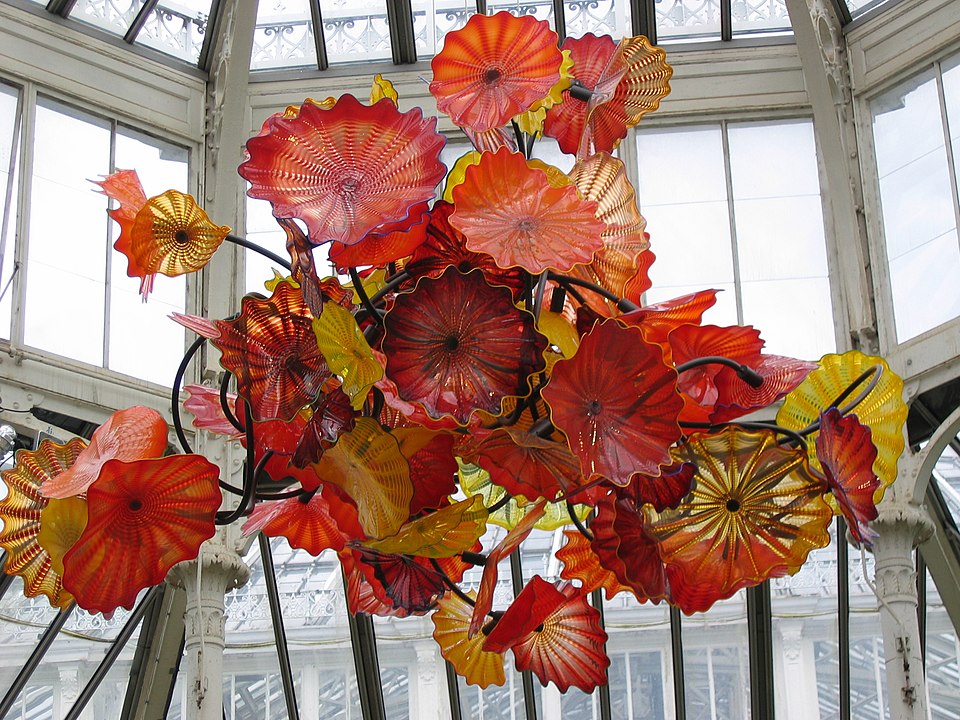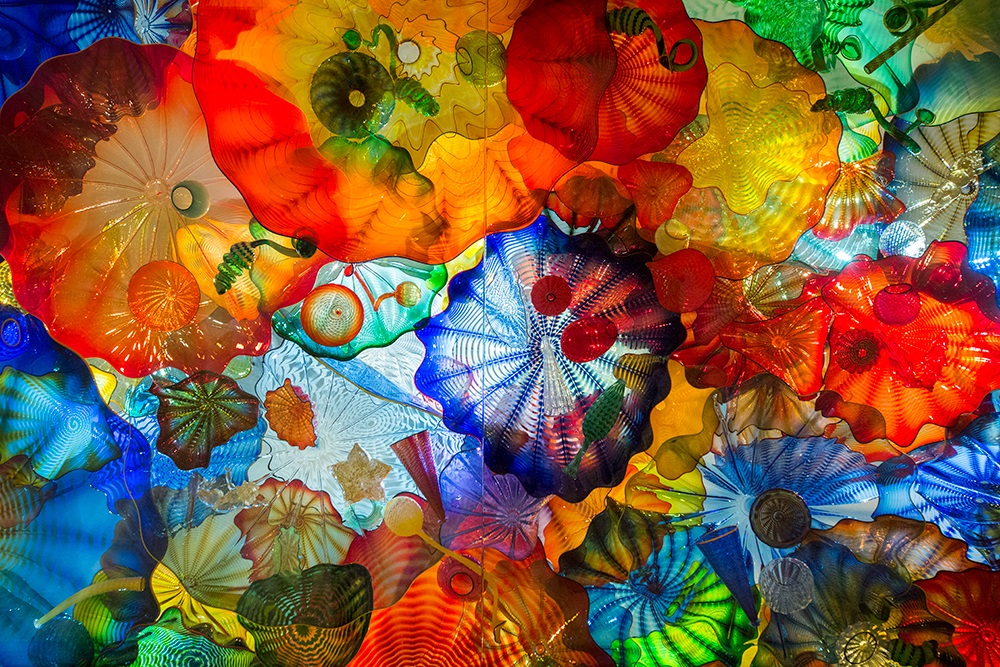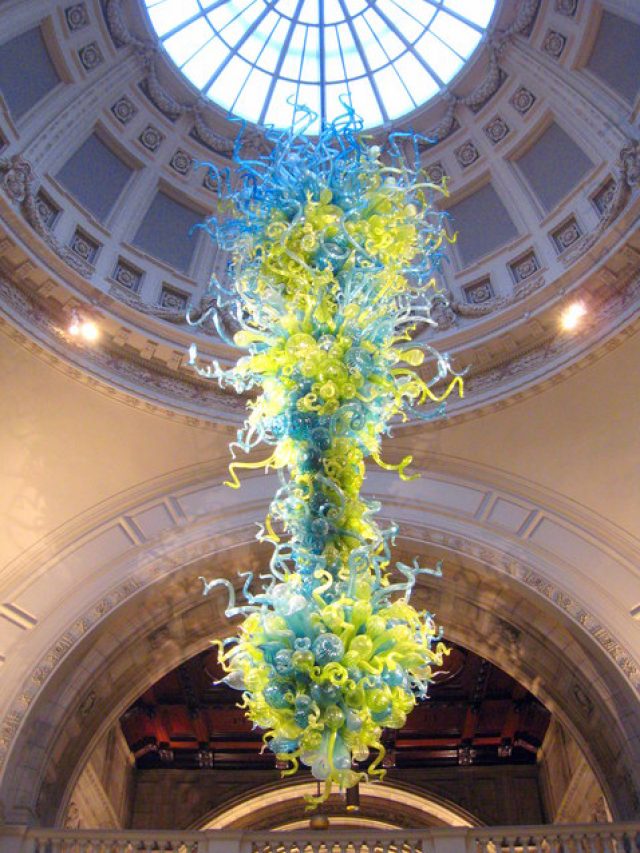Art of Dale Chihuly
Renowned glass artist Dale Chihuly was born in Tacoma, Washington, in 1941. He is well-known for his remarkable contributions to the development of glass art. His work has elevated glass from a simple craft to a recognised modern artistic medium. Throughout a career spanning more than 50 years, Chihuly has created a massive body of work that has won praise and appreciation from all around the world for his intricate glass sculptures and expansive public installations.
After receiving a B.A. in interior design from the University of Washington in 1965, Chihuly’s art career began. An investigation into three-dimensional art was made possible by this foundation. Later, under the direction of Harvey Littleton, a trailblazer in the studio glass movement, he explored glassblowing at the University of Wisconsin, eventually earning an M.S. in sculpting. At the Rhode Island School of Design (RISD), Chihuly pursued further education and graduated with an MFA in ceramics in 1968. He began working with glass during this time, especially at the well-known Venini glass factory in Venice, Italy, where the collaborative nature of glassblowing significantly impacted his creative methods and philosophy.
Chihuly co-founded the Pilchuck Glass School in Washington State in 1971, essential in developing the American Studio Glass movement. This school became an important gathering place for craftspeople and artists, encouraging cooperation and creativity in glass creation. His contribution to the founding of this organisation demonstrated his commitment to fostering the next wave of glass artists and advancing the creative community. A severe car accident that left Chihuly blind in one eye in 1976 was one of the significant turning points in his life. After that, he changed how he worked, depending more on a group of talented artisans to execute his intricate ideas, which enabled him to push the limits of scale and imagination in glass art.
Major Works and Exhibitions
Chihuly has created several groundbreaking series over his career that have impacted the art world. His early pieces, such as the 1970s’ “Cylinders” and “Baskets” series, had organic solid shapes and vivid colours, reflecting his interest in the natural world. Developed in the 1980s, the ‘Macchia’ series consists of rainbow glass vessels with rich, organic designs highlighting his inventive methods and command of colour.
‘Chihuly Over Venice,’ which he started in 1995, is one of Chihuly’s most ambitious undertakings. It involves the installation of large-scale glass sculptures over the canals and piazzas of Venice, producing a magical interaction between the surrounding environment and art. Throughout its existence, this innovative show enthralled more than a million visitors5. ‘Chihuly in the Light of Jerusalem’ (1999) showcased his installations against the historic architecture of the Tower of David Museum; other noteworthy exhibitions include the permanent ‘Chihuly Garden and Glass’ museum, which opened in Seattle in 2012 and honours his contributions to glass artistry.
Significance of His Work

Chihuly has made numerous critical artistic achievements. First, he has expanded the possibilities of glass as a creative medium and made glass art a respectable medium in contemporary art, inspiring a new generation of artists. He has increased art accessibility by incorporating glass art into public areas and encouraging viewers to interact with it in natural settings. His pieces frequently question conventional ideas of what constitutes valuable art. Chihuly’s works aim to stir feeling and cognition, fusing experience and beauty in a way that is not just ornamental or valued. This change has sparked a global admiration for glass art and prompted more extensive discussions about the function of art in society.
In addition, his cooperative style has promoted a collaborative culture in the art world, highlighting the significance of group innovation in creating massive pieces. This way of thinking emphasises the value of each contribution and the collaborative attitude necessary for the creative process.
Aesthetic Elements in Chihuly’s Works
The vibrant colours, organic shapes, and complicated structures define Chihuly’s art. His focus on vivid colours mixes artificial and natural elements, capturing the beauty of natural objects like flowers and sea life. His distinctive style frequently uses firm colour shifts and texture contrasts to evoke strong emotional responses in viewers. Form-wise, Chihuly pushes the limits of glass art, adopting an organic style that reflects the fluidity and movement of natural components. His installations frequently include flowing, undulating patterns that mimic blossoming flowers’ gracefulness or waves’ rippling motion in the ocean. His work is more immersive because of this combination of artistry and nature, which lets spectators experience the interaction between the artwork and its environment.
Chihuly’s mastery of light and space is evident in his expansive installations, such as the magnificent chandeliers and ceiling sculptures. The play of light and glass produces a captivating appearance that highlights the sculpture’s three-dimensionality and illuminates its colours. This deliberate attention to light alters the experience of watching, successfully fusing the artwork with its surroundings and inspiring spectators to perceive the interaction of light and glass in novel ways.
He is considered one of the greatest contemporary artists. You may not remember his name, but you have seen some of his masterpieces via social media, newspapers, magazines or even your local museum. His artworks are recognized worldwide, such as a giant 30-foot-high blown-glass chandelier in the main lobby of Victoria and Albert Museum, London or a huge glass tree in front of the Montreal Public Art Museum (Rao, 2012). However, his successful career cannot deny the fact that there are many unending debates over the question: “Is it art or decoration?” The fans admire Dale Chihuly as one of the most iconic living American artists, and many people are willing to spend thousands of dollars to own one of his artworks.

It is a given that Dale Chihuly’s creations are artefacts. Without his imaginative labour and metamorphosis, Glass is merely a transparent, amorphous material that lacks both colour and shape and is useless. Glass is a common material we use daily in many places. But most of us hardly ever see Glass’s artistic qualities—or, to put it another way, we never acknowledge its beauty. Confucius once said, “Everything has beauty, but not everyone sees it.” Dale Chihuly is one of the very few who can genuinely appreciate Glass’ beauty. Chihuly once observed, “Of all the materials, glass is the most enchanting.”
Regarding the legitimacy of Dale Chihuly’s glasswork, there are a lot of disagreements because he has not performed any blowing himself since 1979. According to what we have been taught in school, using someone else’s work under your name without giving credit is plagiarism. Therefore, since Dale Chihuly does not physically construct “his” collections, referring to him as an artist based on that concept from our educational system is inappropriate. Although hundreds of skilled glassblowers worked on each collection he has, they are all registered under his name.
Conclusion
Dale Chihuly’s artistic career exemplifies a remarkable fusion of inventiveness, tenacity, and imagination. His contributions to glass art have changed people’s opinions on the medium and left a lasting legacy that motivates new and seasoned enthusiasts and artists. Chihuly has contributed to the art world by fusing glass, light, and nature into spectacular artworks that enthral viewers with his bright, colourful creations and collaborative attitude. Beyond the glass domain, Chihuly’s work challenges spectators to recognise the beauty in ordinary life and the transformational potential of art.






